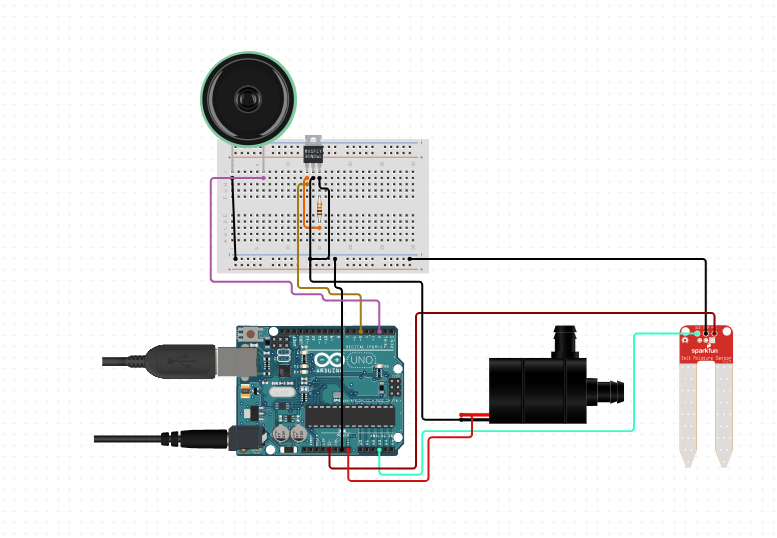Tracking Soil Moisture Levels and Automated Plant Watering System Utilizing IOT Technology
- F. O. Okorodudu
- G. C. Omede
- 1050-1056
- Jun 24, 2024
- Computer Science
Tracking Soil Moisture Levels and Automated Plant Watering System Utilizing IOT Technology
*F. O. Okorodudu and G. C. Omede
Faculty of Sciences, Department of Computer Science, Delta State University, Abraka, Delta State, Nigeria.
DOI: https://doi.org/10.51244/IJRSI.2024.1105070
Received: 17 May 2024; Accepted: 24 May 2024; Published: 24 June 2024
ABSTRACT
Nowadays, technology plays a tremendous role in serving humanity, and food is a man’s basic and primary need. Approximately 70% of Northern Nigerians are directly or indirectly dependent on agriculture. Water pump irrigation cannot be maintained due to frequent power outages, the inaccessibility of grid lines in remote areas, and the scarcity and cost of fuel to run pumps. This IoT-based automatic irrigation system is proposed to create a sustainable field monitoring system for improved crop growth and production. In this system, IOT and WSN control and monitor the irrigation system. IoT collects saved data and monitors diverse soil contents in real time. WSN is utilized to create a user-friendly wireless system for cultivating and irrigating the field. Sensors of several types are utilized. This article uses the “Thing Talk Cloud Server” to operate and monitor a fully automated drip irrigation system. The temperature and humidity of the soil are constantly monitored. The system notifies the user of any abnormal conditions, such as low moisture content, rising temperature, or water concentration, by sending notifications via the wireless module. This will significantly improve food security and the well being of the Nigerian populace all through the year while boosting the economy.
Keywords: Soil, irrigation, Temperature, IoT, Monitoring, Productivity
INTRODUCTION
Agriculture is a critical component of the Nigerian economy and other developing countries, making automation vital for improving efficiency in this industry. A typical farm needs a significant amount of labour. By reducing the amount of physical labour, automation may make farming easier and faster. Automation uses equipment, information technology, and other control systems to increase productivity in producing and delivering goods and services. As a result, it contributes to Nigeria’s aim of self-sufficiency and food security. Agriculture mechanization and computerization in Nigeria are progressing rapidly. However, it is a problematic area to admire and achieve; it requires continuous innovation and identifying technological trends and innovations that stabilize the application of computerization and mechanization in the country and foreign countries. Nigeria has one of the country’s fastest-growing economies, based on agriculture and farming, but it has yet to embrace technology rapidly.
People established numerous types of agriculture, including irrigated agriculture, to supplement rain and sustain agriculture and farming all year round. Irrigation was carried out using canals before the development of contemporary and internet technologies, and this can be traced back to the Egypt and Kush eras when they created canals in the fields as a type of irrigation. Also, small-scale irrigation was carried out using containers and scotch carts, but these methods became outdated because of the necessity to increase the extent of irrigated land.
The Internet of Things and agricultural irrigation: Natural rains sustain most Nigerian agriculture (The World Fact Book, 2017). Because agriculture employs about half of the world’s population, there is a pressing need to boost agricultural output through automation. The Internet of Things Irrigation Control and Automation System is the solution to irrigation farm automation and computerization requirements. The Internet of Things irrigation monitoring and control system is a collection of technology and software that aids in computerizing and automating agriculture, irrigation agriculture, and exactitude (precision) agriculture.
According to Cisco, IOT will generate 14.4 trillion dollars in value for businesses and sectors between 2013 and 2022. Furthermore, recent climatic changes, particularly in Africa, caused by meteorological phenomena such as El Nino increased the demand for large-scale irrigation, and the only solution was automation. The necessity for automation leads to the development of numerous irrigation technologies, such as water pressure-controlled sprinklers, costly centre pivot irrigation systems, and other manually controlled irrigation gear that needs the user to regulate (turn on and off) manually. These irrigation mechanization and automation systems, however, enhance irrigated agriculture. However, most of them are expensive to put up and maintain, require the user to be present at the spot to manage them, and require specialists to run them. When the area of irrigated agriculture was racing for breakthroughs and advances, internet technology seized the scene and has since found a place in every facet of our everyday lives.
LITERATURE REVIEW
Intelligent irrigation systems came about because of the endless possibilities they may provide and the necessity for constant innovation and growth in agricultural technology to complement the economy. When the farmer is away, irrigation must operate independently, or they must maintain control over the water supply to the plants. Because of the expansion of wireless technologies and the Internet of Things, academics and researchers have had several opportunities to delve further into various techniques. Kamthan [1] suggested the development of IoT-automated watering of plants using Raspberry Pi and Android, which uses Raspberry Pi and Arduino as the signal processing and communication hubs. It uses wireless models to transmit and receive sensor data and user interaction. This solution was successful in providing remote irrigation control. However, including a Raspberry Pi only adds superfluous nodes to the network because an Arduino alone can perform these simple, repetitive duties. Amol [2] suggested a PV-powered intelligent irrigation system using a PIC (Peripheral et al.) Controller that employs a solar panel to power the motor and the central system control. This technology reduces the time wasted by today’s manual chamber ON/OFF system by automatically verifying the state of the soil sensor for regulating the chamber using a solenoid valve that runs on a 12-volt DC supply. The sensor output determines whether the valves open or close. The author proposes using the GSM model to control the main motor via mobile messages. These SMSs must be translated into relevant programmed hardware device activities. [3] developed an intelligent irrigation system utilizing the Internet of Things that uses the Internet of Things idea. A Wi-Fi module connects this system to the internet (ESP8266-12). Based on data from a water level indicator and two soil moisture sensors, this module regulates a motor and two solenoid valves that feed water to the field.
Ogini and Franklin [4] presented an IoT-based monitoring device in smart agriculture employing a Simplex Algorithm support system for agricultural production optimization to use developing technologies, namely IoT and intelligent agriculture, through automation. To increase crop output, all environmental elements, such as temperature and humidity monitoring in the field using sensors, play an important role. Umair and Usman [5] suggested and demonstrated an artificial network controller-based method for the irrigation control problem (ANN). Compared to the on/off Controller, this system needs to improve more due to its restrictions. However, ANN-based systems have resulted in the possibility of implementing better, more efficient control, and these controllers, unlike conventional approaches, do not require previous knowledge of the system and have the natural capacity to react to changing conditions. Mousa [6] suggested a system based on computing evapotranspiration (ET) and the needed quantity using a fuzzy inference technique to schedule irrigation based on crop-specific requirements and fluctuations in various climatological parameters. Baker [7] proposed a Programmable Device for Remote Control and Monitoring of Irrigation Systems, which consists of three levels: a microcontroller for information processing using an atmega32 with a control program for real-time measurement and control, a GSM unit for wireless communication with cell phones, and a GSM unit for real-time measurement and control.
A radio frequency transmitter is employed to gather and send data from the field to the Controller, which contains a radio frequency receiver. This system operates using settings supplied by the user via the system keypad based on plant specifications (temperature, humidity). Compared to traditional irrigation systems, this technology saves labour and water while reducing electricity usage by 20% and 30%. On the other hand, ZigBee has a restricted range and is less secure than Wi-Fi. Guerbaoui and Afou [8] created a PC-based Automated Drip Irrigation System, an integrated system for automating drip fertilizing irrigation in a greenhouse. A data acquisition card (PCL-812PG) operated by a PC is used in the solution. [9] used Web and GSM technologies to construct an agricultural automation system. The primary goal of this system is to optimize water use. It detects moisture levels using a soil moisture sensor and a temperature sensor and reservoir water levels using a water level sensor. [10] created a Remote Irrigation Monitoring and Control System for continuous movement systems, which is a system that employs a single-board computer (SBC) with the Linux operating system to operate valves (solenoids) attached to nozzle groups or groups of nozzles.[11] presented a SMART IRRIGATION BASED ON THE INTERNET OF THINGS (IoT) using ZigBee as a wireless transmission. The technology allows the user to manage it remotely using other IoT devices by employing sensors to collect data on the farmland’s temperature, humidity, wetness, and pH level. Centre pivot irrigation is defined by [12] as a crop irrigation technology in which the irrigation equipment revolves around a pivot, and the pivot naturally irrigates a circular region, frequently generating a circular pattern in crops. This technique makes it simple to apply agrochemicals and requires minimal yearly setup.
MATERIALS AND METHOD
When farm attendants have been corrupted, information on the present state of soil provided via manual methods must be removed. The employees’ organization also undermines efforts due to lethargy, failing to disclose problems to farm owners. No automated mechanism communicates an act of harm occurring inside the farming topology to the corporations.
Each issue with any node along the water pipeline impacts the overall architecture.
As a result, this method takes on a new dimension, with each area irrigated having a pipe that brings water from the tank to the farmland. The system also monitors the water level in the tank to ensure that there is always water up there, and it activates the pump when the water level in the tank falls below a certain level. The following analysis is a component of the high-level model:
Component Listing
| Item |
| Arduino Uno |
| PIR Motion Sensor |
| LCD 16*2 |
| 220 Ohm Resistor |
| Rotary Potentiometer |
| Wall Adapter Power Supply: 12VDC, 2A |
| Basic Ultraviolet LED 5mm |
| 100 Ohm Resistor |
| USB Cable A to B |
| Bread Board |
| Jumper wires pack M/M |
 |
Based on the Microchip ATmega328P microcontroller that Arduino. cc developed the Arduino Uno, which is an open-source microcontroller board. The board features digital and analogue I/O pins, which can be connected to various expansion boards and circuits.
Memory: SRAM Storage: Flash, EEPROM Manufacturer: Many |
 |
Speaker for sound output |
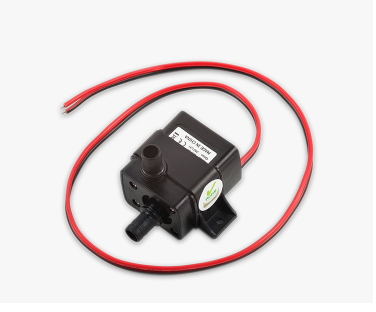 |
Submersible water pumps are used to pump water for irrigating crops. |
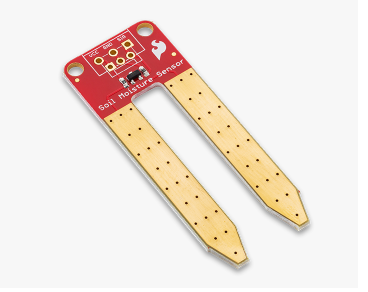 |
Soil Moisture Sensor for determining the soil moisture level |
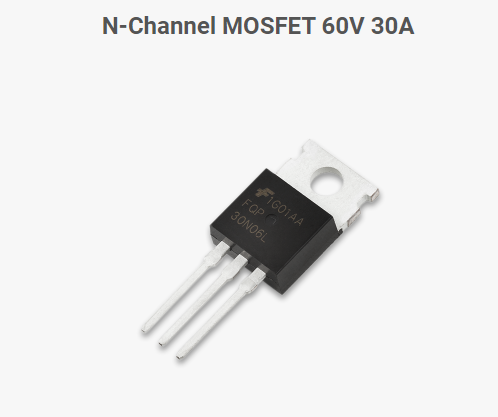 |
Memory devices and microprocessors often consist of a substantial number of MOSFETs, often ranging from hundreds of thousands to millions. As a result, MOSFETs have emerged as the predominant kind of field-effect transistor used in digital circuits. The application of a voltage controls the insulated gate of the device’s conductivity. The capacity to modify conductivity in reaction to an imposed voltage may be used for signal amplification and signal switching. |
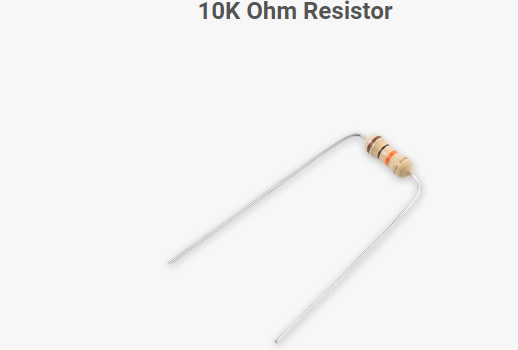 |
A resistor is a passive, two-terminal component that implements electrical resistance as a circuit element. In electronic circuits, resistors reduce current flow, adjust signal levels, divide voltages, bias active elements, terminate transmission lines, and more. |
Figure. 1: Automatic Irrigation System
In this paper, we are developing an innovative Internet of Things-based watering system using Arduino, a moisture sensor, and an LDR. When the moisture level drops below a particular threshold, it will automatically water the plants. It will also communicate moisture data to the Arduino IO Server and display it on the serial monitor to monitor the status of the land.
Figure. 2: system flowchart
Figure 2 depicts how the system takes turns monitoring the moisture or dryness level of the soil in order to activate the irrigation system and stop when a specified level of moisture is reached.
DISCUSSION
Using Arduino, a moisture sensor, and an LDR, we are creating an innovative Internet of Things-based watering system in this work. When moisture falls below a certain level, it automatically sprinkles water on the plants. To monitor the state of the land, it will also transmit the moisture data to the Arduino IO Server and show it on the serial monitor. Therefore, the system’s empirical analysis is based on the functional realities of existing irrigation measures, from where an empirical design of the new system can be achieved.
In this system, the soil dryness or moisture nature is considered to be an act of triggering irrigation if:
- The soil dryness or moisture level reaches a particular stage
- The irrigation of some certain depends on the type of crop planted and the amount it requires
- Fertilizer is applied on the farmland
The agricultural method of applying precise water amounts to land to aid crop growth and nurture landscape flora and lawns is called irrigation (sometimes spelt irrigation). Rain-fed agriculture refers to farming that eschews irrigation, depending solely on natural rainfall. Over 5,000 years ago, irrigation became a crucial aspect of agriculture, and several cultures worldwide have independently developed it since then.
Using Arduino, a moisture sensor, and an LDR, we are creating an innovative Internet of Things-based watering system in this project. When moisture falls below a certain level, it automatically sprinkles water on the plants. To monitor the state of the land, it will also transmit the moisture data to the Arduino IO Server and show it on the serial monitor.
CONCLUSION
The technology under consideration is a hardware architecture capable of monitoring soil dryness and moisture to trigger the irrigation system. The present system’s key technological measures are its vast data handling capacity and real-time detection and localization of soil dryness and moisture levels. Most of these systems are automated but cannot immediately activate the machine at the central server. Typically, plants would have been weak before any action was taken.
The relative irregular monitoring of soil dryness and wetness is required to know the plant’s state for action in the following stage.
The constraints above, among other things, compelled the new method to reveal the anonymity of soil dryness and moisture level in the shortest possible time and to maximize the reaction efficiency of relevant agencies. Hopefully, this would improve agricultural yield and food supplies all year round, minimizing food shortages.
REFERENCES
- Kamthan, J. (2017). ‘IOT-Based Automatic Watering of Plants Using Raspberry Pi and Android’, 3(10), pp. 389–393.
- Amol, P., Bhaskar, A., Kishor, C., &Burungale, V. D. (2017). ‘SOLAR POWER-BASED SMART IRRIGATION’, 2(3), pp. 122–125.
- Kumbar, B., Galagi, B., Bheemashankar, &Honnalli, N. (2016). ‘Smart Irrigation System Using the Internet of Things’, Bonfring International Journal of Research in Communication Engineering, 6 (Special Issue), pp. 4–09. doi: 10.9756/BIJRCE.8189.
- Ogini, N. O., & Okorodudu, F. O. (2021), ‘Simplex Algorithm Support System for Optimization of Crop Yield Monitoring System Using the Internet of Things (IoT)’, International Journal of Research and Innovation in Applied Science (IJRIAS), Volume VI, Issue III, March 2021, ISSN 2454-6194, pp. 25–27.
- Umair, S. M., & Usman, R. (2010). ‘Automation of Irrigation System Using an ANN-based Controller’, (2), pp. 1–7.
- Mousa, A. K., Croock, M. S. & Abdullah, M. N. (2014) ‘Fuzzy Based Decision Support Model for Irrigation System Management’, International Journal of Computer Applications, 104(9), pp. 14–20.
- Baker, T. (2014). ‘Design and implementation of a programmable remote controlled and monitored irrigation system’, 4(12), pp. 25–29.
- Guerbaoui, M., & Afou, Y. E. L. (2013). ‘PC-BASED AUTOMATED DRIP IRRIGATION SYSTEM’, 5(1), pp. 221–225.
- Srija, V., & Krishna, P. B. M. (2015). ‘GSM Technologies’, (9), pp. 1201–1209. Available at: http://en.wikipedia.org/wiki/GSM.
- Francis, Æ., Todd, J. P. Æ., & Robert, V. E. Æ. (2010). A remote irrigation monitoring and control description and development Doi 10.1007/s11119-0099109-1.
- Raut, M. M., Sable, R. R., & Toraskar, S. R. (2016). ‘Internet of Things (IoT)-Based Smart Grid’, 34(1), pp. 15–20.
- Energy, N., and Alliance, E. (2015), ‘Agricultural Irrigation Initiative: Overview of Center Pivot Irrigation Systems’.

